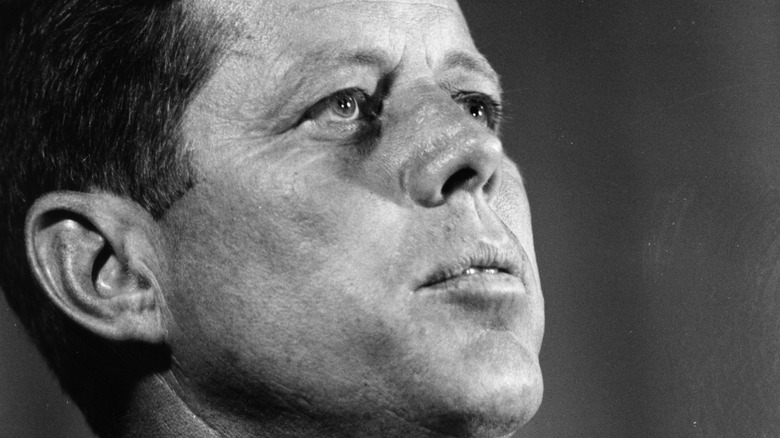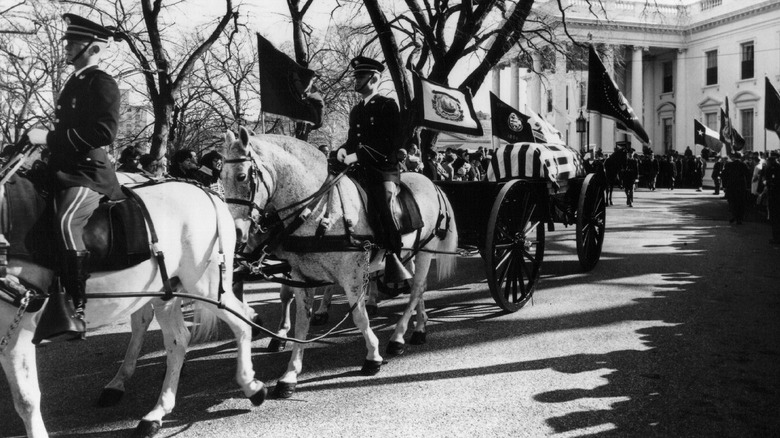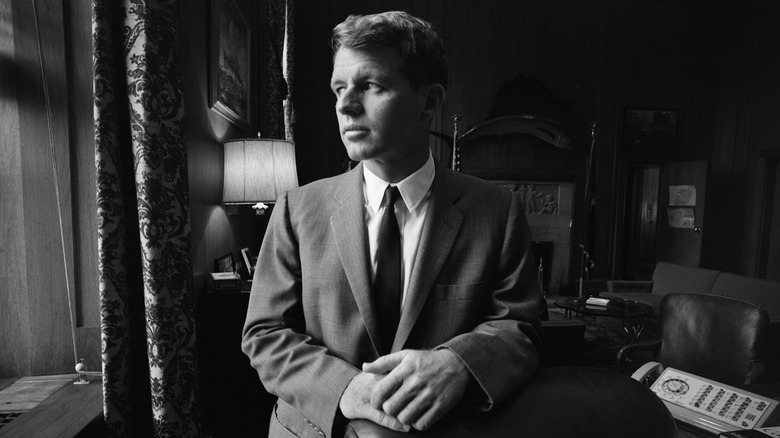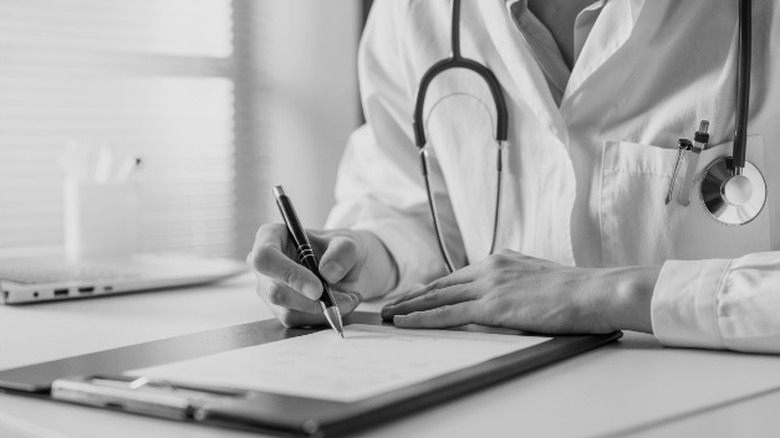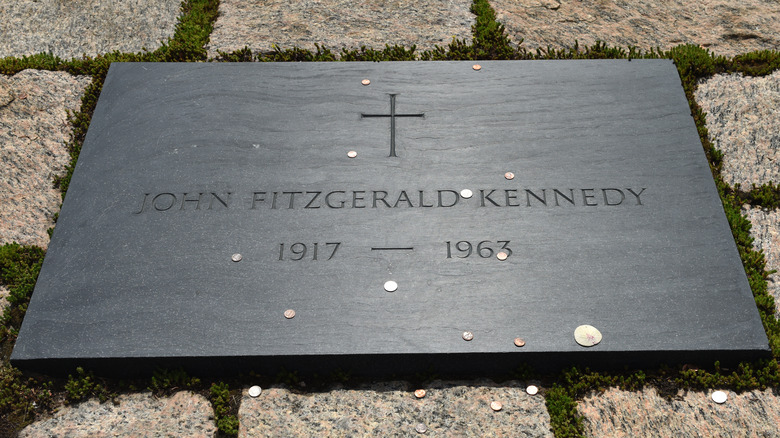The Mysterious Disappearance Of JFK's Brain
In November 1963, President John F. Kennedy was in the midst of his campaign for the 1964 election. During his tour of the United States, Kennedy's primary focus was confirming his commitment to conservation efforts and the preservation of natural resources. However, as reported by JFK Library, he was also promoting a renewed focus on education, national security, and world peace. As winning the state of Texas was essential for his reelection, Kennedy planned a two-day tour of the Lone Star State, which would include stops in five cities. President Kennedy and the first lady arrived in Texas on November 21. On the second day of their tour they arrived in Dallas, where they planned a 10-mile procession beginning at Love Field, proceeding through downtown Dallas, and ending at the Trade Mart, where Kennedy planned to attend a luncheon.
During the procession, JFK Library reports the Kennedys rode in a convertible limousine with Texas Governor John Connally and his wife, Nellie. At approximately 12:30 p.m. on November 22, the vehicle was approaching Dealey Plaza when shots were fired directly at the limousine. Governor Connally was shot in the back. Although his injuries were serious, he survived the assault. President Kennedy, however, who was shot in the head and neck, was pronounced dead approximately 30 minutes after the shooting occurred.
President Kennedy's body was ultimately laid to rest in Washington, D.C.'s Arlington National Cemetery. However, his brain was not buried with his body, and the whereabouts of the organ remain unknown.
John F. Kennedy's brain was not buried with his body
The circumstances surrounding the assassination of President John F. Kennedy remain a point of heated controversy and a favorite topic among conspiracy theorists. The disappearance of Kennedy's brain has only fueled the rumors and speculation.
Immediately following the shooting, NeuroTray reports Kennedy was transported to Parkland Hospital where his wounds were determined to be fatal. Kennedy was ultimately declared dead by his personal physician, Rear Admiral Dr. George Burkley, who also concluded the cause of death was a gunshot wound to the skull. Kennedy's body was transported back to Washington D.C., aboard Air Force One. Upon arrival, it was taken to Naval Hospital in Bethesda, Maryland, for an official autopsy. As reported by NeuroTray, the coroner concluded Kennedy was struck by two bullets. One of the bullets entered at the base of the neck and exited through the throat. The second bullet, which entered the back of the head near the crown, caused extensive damage to the right cerebral hemisphere and left a 13.5 cm hole in the skull.
Amid the autopsy, Kennedy's brain was removed from his skull and, as reported by Vanity Fair, was placed in a stainless-steel container. The brain, along with several other pieces of evidence, were initially placed in the offices of the Secret Service, stored in a filing cabinet. It was later moved to a footlocker before being moved to the National Archives and what was described as a "secure room."
John F. Kennedy's brain was discovered to be missing in 1966
Prior to moving the items to the National Archives, NeuroTray reports, Secret Service agents cataloged the evidence and confirmed everything was accounted for and intact. In addition to John F. Kennedy's brain, the evidence included other tissue samples, bone fragments, photographs, and X-rays taken during the autopsy. The cabinet containing the brain and the rest of the evidence was discovered to be missing from the National Archives on October 31, 1966.
Although it is unclear what actually happened to Kennedy's brain, there are numerous theories that offer some interesting possibilities. As reported by The Vintage News, it has been suggested that the brain and other evidence was hidden to cover up details about the assassination. Conspiracy theorists believe Kennedy's brain may be the only physical evidence proving the actual trajectory of the bullets that killed him. Therefore, they believe its location is being concealed to make sure nobody finds out what really happened.
Other theories suggest the brain and other evidence were stolen by Kennedy's brother Robert. According to NeuroTray, Robert F. Kennedy sent a letter, dated April 22, 1965, to Dr. Bourkley. In the letter, Robert asked Bourkley to send the brain to his brother's former secretary, Evelyn Lincoln, who was in the process of cataloging his belongings for eventual transfer to the National Archives. Robert also told Bourkley to discuss any plans pertaining to the brain with him before any decisions were made.
Some theories suggest Robert F. Kennedy stole his brother's brain
As reported by Historic Mysteries, it was ultimately Robert F. Kennedy's decision to move John F. Kennedy's brain to the National Archives. Author James L. Swanson has suggested Robert either took the brain and other evidence before it made it to the Archive or stole it at a later date. Although conspiracy theorists suggest the brain was stolen to conceal details about the assassination, Swanson suggests Robert was instead trying to conceal his brother's drug use and medical conditions, which were not previously disclosed to the public.
PBS reports one of the most serious health concerns Kennedy had was a condition called Addison's disease. Caused by an adrenal gland insufficiency, Addison's disease disrupts the body's ability to regulate adrenaline, glucose, potassium, and sodium. Although it can be fatal, Addison's disease can be managed with corticosteroids. According to PBS, it is believed that Kennedy began taking corticosteroids in the mid to late 1940s.
An unfortunate side effect of long-term use of corticosteroids is osteoporosis, which Kennedy had been diagnosed with. The osteoporosis, along with some old football injuries and further damage he suffered during his military service in World War II, caused him constant pain later in life. By the early 1960s, PBS reports Kennedy was taking a wide variety of medications. In addition to the steroids, he was taking testosterone to treat the Addison's disease, antibiotics for recurrent urinary tract infections, and antispasmodics to treat colitis and irritable bowel syndrome.
Some theories suggest there were actually two different brains
As reported by ABC News, President Kennedy was also taking a variety of other medications to address various issues. His medical records reveal that, at times, he was taking as many as 12 different prescription medications. Prior to and during his presidency, Kennedy took codeine, Demerol, and methadone for pain, meprobamate and librium for anxiety, barbiturates to help him sleep, and gamma globulin to treat infections. He was also prescribed antipsychotic medication on at least one occasion.
Although it is possible Robert F. Kennedy may have taken his brother's brain to prevent the public from ever knowing the true extent of the president's medical conditions, it seems to be an extreme measure to cloak information that would eventually be revealed with the release of his medical records. However, John F. Kennedy himself closely guarded his medical conditions and the medications he took for those conditions throughout his political career. ABC news reports he denied having Addison's disease and his doctors confirmed his assertions that he was in "excellent" health.
It has also been suggested that the doctors who performed Kennedy's autopsy had possession of two different brains, and it is unclear what happened to either of them. As reported by The Irish Times, the first examination of Kennedy's brain was conducted on November 22, 1963, during the official autopsy. However, at least two doctors have conflicting reports about further examinations of the brain.
John F. Kennedy's brain has yet to be found
The Irish Times reports Dr. J. Thornton Boswell said a second examination of John F. Kennedy's brain was conducted on November 25, which was the day his body was laid to rest. However, Dr. Pierre Finck said he, along with Dr. Boswell and Dr. James Humes, examined the brain again on November 29. During that examination, photos were taken of the brain, which sparked the theory that two different brains were being examined. Assassinations Records Review Board chief analyst Douglas Horne said the brain photographed during the November 29 examination probably was not Kennedy's brain. As reported by The Irish Times, Horne said the brain in the photographs had far less damage than was mentioned in the official autopsy.
Horne also said he believes the first brain, which was autopsied, actually proved Kennedy was shot from the front, whereas the second brain, which was examined and photographed on November 29, appeared to have been struck from behind. In an interview with The Washington Post, Horne said he is 90% to 95% "certain that the photographs in the Archives are not of President Kennedy's brain." Dr. J. Thornton Boswell, who participated in the November 22 and November 25 examinations of Kennedy's brain, said "it was the same brain." He vehemently denied Horne's accusation about the presence of a second brain. As of this writing, Kennedy's brain is still missing and there is no conclusive proof as to what actually happened to the organ.
